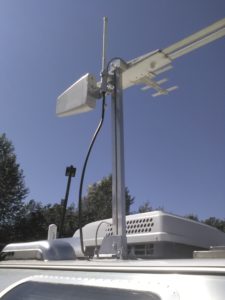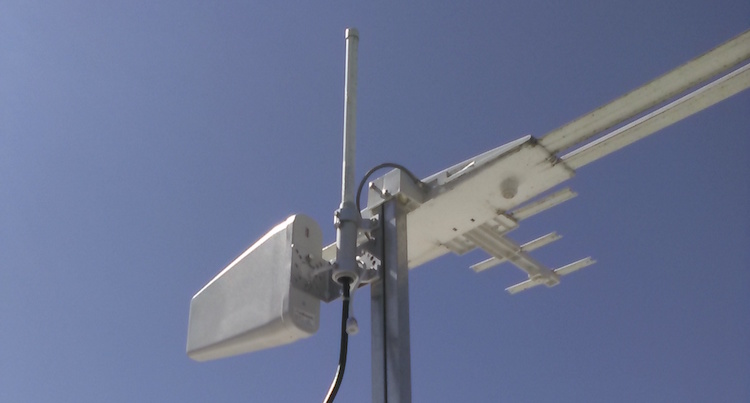 Since we’re mobile and working, connectivity is essential. We also want to try our hand at extended boondocking, so power is another hurdle we have to consider. Over the past year I’ve slowly upgraded and added various systems to our Airstream that will enable us to live this lifestyle, I figure I ought to outline what we’ve done, maybe it will help others down the road.
Since we’re mobile and working, connectivity is essential. We also want to try our hand at extended boondocking, so power is another hurdle we have to consider. Over the past year I’ve slowly upgraded and added various systems to our Airstream that will enable us to live this lifestyle, I figure I ought to outline what we’ve done, maybe it will help others down the road.
Keeping connected is critical for me in my job. On a daily basis I have video meetings with people across North America and often in other countries. I’m constantly online for chats, and of course the many tools of trade are all online these days. Beth also has video sessions with some of her clients as well as various people she works with. Add to all that a need for data in both Canada and the US and you can see we’re a special kind of “special”.
No simple data plan is sufficient for our needs, and Wifi in RV Parks is worse than hotels. The park we’re currently in limits you to 512MB/day, and if you go over you get dinged for $20. In many respects, RV parks are in the stone age when it comes to technology, slow occasionally working networks with bandwidth limits.
So how do we manage?
Cellular Data Plans
We primarily rely on cellular data from multiple providers. Data is likely our largest expense, but for us that is the cost of living this lifestyle. Here’s the breakdown:
- USA
- Verizon grandfathered unlimited data plan
We picked up the grandfathered plan less than 24 hours before Verizon changed their policies and disallowed transferring plans to other people. This will hopefully be the mainstay of our data when in the US, but as we discovered last year, there were times that Verizon simply didn’t cut it. In that case, we relied on AT&T. - AT&T 40GB plan [we discontinued this]
Last year AT&T ran a special where they offered 2X the data at the same price, we picked up the 40GB plan and made great use of it during our winter trip. I forgot to cancel it when we no longer needed it, so it probably didn’t save us money in the end, but we couldn’t have done without it. - TMobile [new plan as of mid-September]
Now that TMobile has roaming in Canada and Mexico, I decided we should try it out as well as write about it. There are so few options for mobile workers in Canada, this seems like it would be a great fit for those who spend enough time in the US to avoid their fair use policy. It hasn’t worked out too great for us yet, but I have hope.
- Verizon grandfathered unlimited data plan
- Canada
- Rogers Flex Heavy plan
Rogers 30GB plan[already grandfathered, no longer available]
This is one behemoth of an expense when you think about cellular plans, but it has been able to keep us online at a reasonable speed, and nearly covers our monthly data needs. It’s actually sufficient if we lay off the Netflix. We’ll also be able to roam to the US with Rogers, adding another $50/month/device to our costs. Worth it to keep use of our phone numbers, but maybe not so worth it for running data off our hotspot, this is something I still need to calculate against having another account from a US provider, but since Rogers roams on AT&T, it may be most cost efficient just to roam for data.- Wind.ca [thinking about it]
You can think of Wind as TMobile for Canada. The interesting thing about Wind is their roaming in the US is MUCH cheaper than Rogers. A combination of having Wind and AT&T may actually save us a chunk of money over roaming with Rogers, however Wind seems to have a particularly strong fair use clause related to international roaming. I’m not sure it would work for snowbirds. As well, Rogers simply has better coverage for trips across Canada.
Cellular Boosters
Now that we have the GigaBytes, we also need to ensure we have a proper connection. We’ve already discovered that places we tend to like are a little out of the way and cellular connections are not always great. We also live in a Faraday Cage. Time, research and recommendations from other blogging/roaming tech workers led me to adding boosters and antennas to our shiny home. For a really in-depth run down of the technology you should check out Technomadia.com
 |
weBoost Drive Actually, we have the predecessor, a Wilson 4G booster. Wilson rebranded to weBoost some time ago. This booster gives us a good 20% signal increase at our current location south of Vancouver, BC. |
 |
BoatAnt™ Marine Antenna This little antenna sits up on top our our Airstream. We had a wire pulled through the refrigerator exhaust vent and into the cabinet above the refrigerator where most of the communications electronics have ended up. |
 |
Wide Band Directional Antenna There’s a good chance I’ll try out a directional antenna. With only a 40% signal strength in our current location (only 20% without the above booster and antenna) I feel a directional may give us better speeds.Update: I installed the directional antenna, and while we’ve moved parks and have better coverage, it still provides about a 10db gain in signal. |
That pretty much wraps up our cellular story. We’ve been able to keep working, keep video conferencing and watch a few netflicks here and there. As Cell technology continues to advance and get cheaper, I expect many of the nuisances and costs we encounter will go away, but that may still be a few years off.

